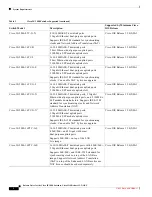
12
Release Notes for the Cisco IE 2000 Switches, Cisco IOS Release 15.2(1)EY
NEW DOC # PENDING
Limitations and Restrictions
–
for random source-ip and dest-ip traffic, configure load balance method as
src-dst-ip
–
for incrementing source-ip traffic, configure load balance method as
src-ip
–
for incrementing dest-ip traffic, configure load balance method as
dst-ip
–
Configure the number of ports in the EtherChannel so that the number is equal to a power of 2
(i.e. 2, 4, or 8)
For example, with load balance configured as
dst-ip
with 150 distinct incrementing destination IP
addresses, and the number of ports in the EtherChannel set to either 2, 4, or 8, load distribution is
optimal.(CSCeh81991)
IP
•
When the rate of received DHCP requests
exceeds 2,000 packets per minute for a long time, the
response time might be slow when you are using the console.
The workaround is to use rate limiting on DHCP traffic to prevent a denial of service attack from
occurring. (CSCeb59166)
QoS
•
Some switch queues are disabled if the buffer size or threshold level is set too low with the
mls qos
queue-set output
global configuration command. The ratio of buffer size to threshold level should
be greater than 10 to avoid disabling the queue.
The workaround is to choose compatible buffer sizes and threshold levels. (CSCea76893)
•
When auto-QoS is enabled on the switch, priority queuing is not enabled. Instead, the switch uses
shaped round robin (SRR) as the queuing mechanism. The auto-QoS feature is designed on each
platform based on the feature set and hardware limitations, and the queuing mechanism supported
on each platform might be different. There is no workaround. (CSCee22591)
RADIUS
•
RADIUS change of authorization (COA) reauthorization is not supported on the critical auth
VLAN.
There is no workaround. (CSCta05071)
SPAN and RSPAN
•
When the RSPAN feature is configured on a switch, Cisco Discovery Protocol (CDP) packets
received from the RSPAN source ports are tagged with the RSPAN VLAN ID and forwarded to trunk
ports carrying the RSPAN VLAN. When this happens a switch that is more than one hop away
incorrectly lists the switch that is connected to the RSPAN source port as a CDP neighbor.
This is a hardware limitation. The workaround is to disable CDP on all interfaces carrying the
RSPAN VLAN on the device connected to the switch. (CSCeb32326)
•
CDP, VLAN Trunking Protocol (VTP), and Port Aggregation Protocol (PAgP) packets received
from a SPAN source are not sent to the destination interfaces of a local SPAN session. The
workaround is to use the
monitor session
session_number
destination
{
interface
interface-id
encapsulation replicate
}
global configuration command for local SPAN. (CSCed24036)




































